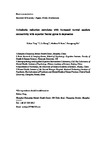Anhedonia reduction correlates with increased ventral caudate connectivity with superior frontal gyrus in depression.
| dc.contributor.author | Yang, X | |
| dc.contributor.author | Huang, J | |
| dc.contributor.author | Roser, ME | |
| dc.contributor.author | Guangrong, X | |
| dc.date.accessioned | 2022-05-03T14:47:46Z | |
| dc.date.issued | 2022-07 | |
| dc.identifier.issn | 0022-3956 | |
| dc.identifier.issn | 1879-1379 | |
| dc.identifier.uri | http://hdl.handle.net/10026.1/19153 | |
| dc.description.abstract |
This study was to investigate the relationship between the ventral caudate connectivity and anhedonia. Nineteen depressed patients and 16 healthy controls participated in two identical functional magnetic resonance imaging scans during a 1-year period to determine the resting-state functional connectivity changes using a seed-based approach. Patients showed increased left ventral caudate functional connectivity with superior frontal gyrus over time and the increased connectivity was associated with anhedonia improvement. None of these associations were observed in healthy controls. The findings suggest that left ventral caudate may serve as a potential target to improve the severity of anhedonia. | |
| dc.format.extent | 286-290 | |
| dc.format.medium | Print-Electronic | |
| dc.language | en | |
| dc.language.iso | en | |
| dc.publisher | Elsevier | |
| dc.subject | Anhedonia | |
| dc.subject | Ventral caudate | |
| dc.subject | Superior frontal gyrus | |
| dc.title | Anhedonia reduction correlates with increased ventral caudate connectivity with superior frontal gyrus in depression. | |
| dc.type | journal-article | |
| dc.type | Journal Article | |
| dc.type | Research Support, Non-U.S. Gov't | |
| plymouth.author-url | https://www.webofscience.com/api/gateway?GWVersion=2&SrcApp=PARTNER_APP&SrcAuth=LinksAMR&KeyUT=WOS:000806169400011&DestLinkType=FullRecord&DestApp=ALL_WOS&UsrCustomerID=11bb513d99f797142bcfeffcc58ea008 | |
| plymouth.volume | 151 | |
| plymouth.publication-status | Published | |
| plymouth.journal | Journal of Psychiatric Research | |
| dc.identifier.doi | 10.1016/j.jpsychires.2022.04.030 | |
| plymouth.organisational-group | /Plymouth | |
| plymouth.organisational-group | /Plymouth/Faculty of Health | |
| plymouth.organisational-group | /Plymouth/Faculty of Health/School of Psychology | |
| plymouth.organisational-group | /Plymouth/REF 2021 Researchers by UoA | |
| plymouth.organisational-group | /Plymouth/REF 2021 Researchers by UoA/UoA04 Psychology, Psychiatry and Neuroscience | |
| plymouth.organisational-group | /Plymouth/Research Groups | |
| plymouth.organisational-group | /Plymouth/Research Groups/Centre for Brain, Cognition and Behaviour (CBCB) | |
| plymouth.organisational-group | /Plymouth/Research Groups/Centre for Brain, Cognition and Behaviour (CBCB)/Brain | |
| plymouth.organisational-group | /Plymouth/Users by role | |
| plymouth.organisational-group | /Plymouth/Users by role/Academics | |
| dc.publisher.place | England | |
| dcterms.dateAccepted | 2022-04-25 | |
| dc.rights.embargodate | 2023-5-4 | |
| dc.identifier.eissn | 1879-1379 | |
| dc.rights.embargoperiod | Not known | |
| rioxxterms.versionofrecord | 10.1016/j.jpsychires.2022.04.030 | |
| rioxxterms.licenseref.uri | http://www.rioxx.net/licenses/all-rights-reserved | |
| rioxxterms.type | Journal Article/Review |


